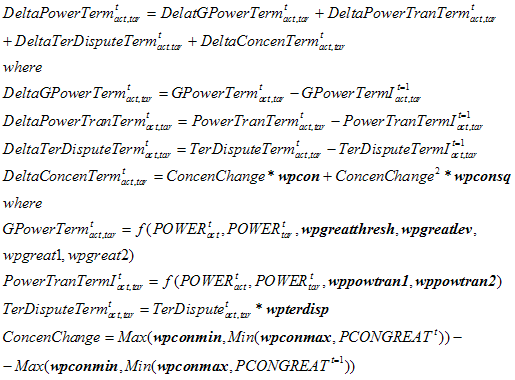International Futures Help System
IP Equations: Power Term for Threat
The threat calculation builds on an initial, constant term plus a delta power term (that is, a change in power term) and a delta non-power term. This topic explains the power term. It is a sum of four other terms: delta great power term (DeltaGPowerTerm), delta power transition term (DeltaPowerTranTerm), delta territorial dispute term (DeltaTerDisputeTerm), and delta power concentration term (DeltaConcenTerm). See the Initial Threat Topic for a discussion of the foundational elements of the first three of these. The delta term for each is the foundational term in a future year minus the initial value of the term. The only new term in future years is the delta power concentration term (DeltaConcenTerm), explained below.

Power concentration is a concept focusing on the degree to which the power structure of the great powers (not all powers in the system) is heavily concentrated or not. The measure poses an alternative to the often less systematic estimation of whether a system is multipolar, bipolar, etc. (Singer, Bremer, and Stuckey 1972). IFs calculates systemic power concentration using the Ray and Singer (1973) calculation approach,

More specifically, IFs calculates four versions of power concentration. The first (PCONGREAT) is the most traditional, using a fixed cut-off for defining great powers (wpgreatlev) and normally setting that value at 5%. The measure also treats all European Union members as individual countries. The second variation (PCONGREATEU) treats the European Union as a single entity. The user has a parameter (eumembsw) to define membership in the EU over time. Although few would argue that it currently acts as a single great power, greater unity is possible in the future. Both of the first two measures are, however, somewhat erratic in forecasts, because they make a fixed distinction about great power status at the threshold level. Thus if Japan drops below five percent of systemic power (as it normally does relatively early in the base case), the number of powers considered changes and there is a transient in the calculation of power concentration. Because that seems rather arbitrary, a third measure (PCONGREATF) uses a more flexible measure of great power, phasing the status in or out above a threshold (wpgreatthresh) up to full status (wpgreatlev). The fourth measure does the same for the single EU variant (PCONGREATEUF). For completeness, IFs also calculates a global concentration measure (PCONSYS), not distinguishing between great and other powers.
Edward Mansfield (1994) has investigated the relationship between power concentration of great powers and propensity for war in the system, finding a non-linear pattern with war most likely at highest and lowest system concentration levels. Bennett and Stam (2003) investigated the relationship for MIDs rather than wars, and found parameters about half the magnitude that Mansfield reported for wars. IFs uses a Mansfield-type non-linear formulation, with reduced parameters more appropriate to disputes rather than wars (remember that the IFs approach is a fundamentally stylized one, bringing together insights from much research rather than relying on a single analysis).
The Mansfield formulation looks to change in power concentration (ConcenChange) and to the square of change in power concentration for impact on the threat of conflict, which is the reason that power concentration enters only the delta term, not the initial term. Parameters on the change in power concentration (wpcon) and the square of the change (wpconsq) determine the ultimate concentration term. Also in the above calculation, power concentration is bound at all time points to be between a minimum (wpconmin) and maximum (wpconmax) value. Mansfield suggests that the analysis is only valid for values between .202 and .417.
 International Futures at the Pardee Center
International Futures at the Pardee Center